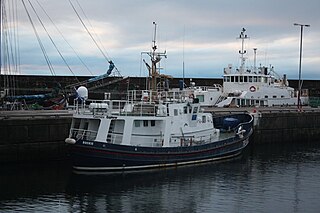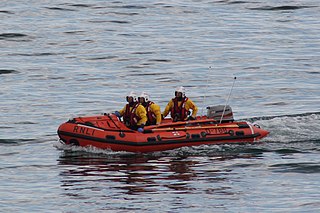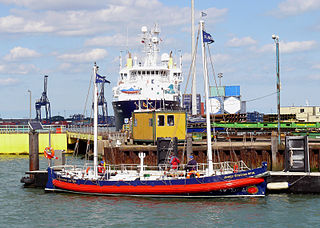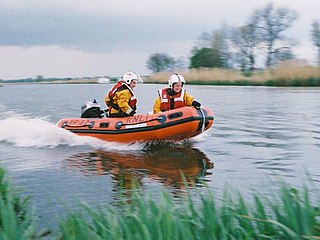 W
WThe Arancia-class inshore rescue craft is a class of small inflatable rescue boat (IRB) operated by Surf Life Saving Great Britain, Surf Lifesaving Wales and the RNLI of the United Kingdom and Ireland.
 W
WThe Brede-class lifeboat was operated by the Royal National Lifeboat Institution (RNLI) from its stations around the coasts of the United Kingdom between 1982 and 2002, at which time it was the fastest all-weather lifeboat in its fleet. Eleven were put into service and when replaced by larger boats seven were sold for further use as lifeboats, mainly in South Africa.
 W
WThe Clyde-class lifeboat was operated by the Royal National Lifeboat Institution (RNLI) from two of its stations in the United Kingdom, Kirkwall and Clovelly. Only three vessels were built for the RNLI, however a fourth vessel was built in the Netherlands to the same lines as 70-001 and 70-003 as a pilot boat for Trinity House.
 W
WThe D-class (EA16) lifeboat is a class of inflatable boat operated since 1987 by the Royal National Lifeboat Institution of the United Kingdom and Ireland. It has been replaced operationally by the D-class (IB1), but many are still used as part of the relief fleet, as boarding boats for the larger classes of lifeboat and by the RNLI Flood Rescue Team.
 W
WThe D-class (IB1) lifeboats are inflatable boats serving in the UK's RNLI inshore lifeboat (ILB) fleet. Although they are known as the "IB1" at times, they are the latest development of the D-class lifeboat and as such are mainly referred to as a "D-class".
 W
WThe E-class lifeboat forms part of the RNLI fleet in the United Kingdom, operating exclusively in the tidal reach of the River Thames in London. The class was introduced in 2002 to serve the tidal reach of the River Thames, which had not previously been covered by an RNLI rescue service, as a result of a much delayed enquiry into the Marchioness disaster in 1989, in which 51 people died. The enquiry criticised the lack of a rescue service for the tidal Thames, and the UK government asked the Maritime and Coastguard Agency, the Port of London Authority and the RNLI to work together to set up a dedicated Search and Rescue service for this stretch of the river.
 W
WH-class rescue hovercraft serve the shores of the United Kingdom as a part of the RNLI inshore fleet. The class are of a modified Type 470TD design built by Griffon Hoverwork.
 W
WThe James Stevens lifeboats were a series of twenty lifeboats which were purchased by the Royal National Lifeboat Institution (RNLI) using a £50,000 legacy received in 1894 from the estate of Mr James Stevens, of The Reform Club, Birmingham, UK, an Edgbaston property developer, which was provided for this purpose. This donation provided more boats than any other donation received by the RNLI..
 W
WCalshot Lifeboat Station is located on Calshot Spit near the village of Calshot, Hampshire, and is on the southern bank of the open end of Southampton Water, on the south coast of England. The station is owned and operated by the RNLI and currently operates two inshore lifeboats. They are an Atlantic 85 called Max Walls (B-860) and a D-class (IB1) called RNLB Willett (D-748).
 W
WThe McLachlan-class lifeboat was part of the A class of lifeboats formerly operated by the Royal National Lifeboat Institution of the United Kingdom and Ireland. It was replaced by the Atlantic 21.
 W
WThe Medina-class lifeboat was a prototype Rigid Inflatable Boat that was considered by the Royal National Lifeboat Institution of the United Kingdom and Ireland in 1980s. It was based on the design of the Atlantic 21-class lifeboats.
 W
WAt 17.3 metres long, the Severn class is the largest lifeboat operated by the Royal National Lifeboat Institution (RNLI). Introduced to service in 1996, the class is named after the River Severn, the longest river in Great Britain. They are stationed at 35 locations around the coasts of the United Kingdom and Ireland to provide coverage up to 50 miles (80 km) out to sea.
 W
WThe Shannon-class lifeboat is the latest class of lifeboat currently being deployed to the RNLI fleet to serve the shores of the British Isles. The Shannon class will replace the Mersey class carriage-launched lifeboat and, the remaining Tyne-class lifeboats and will also replace the Trent-class lifeboats in due course.
 W
WThe Trent-class lifeboat is an all-weather lifeboat operated by the Royal National Lifeboat Institution (RNLI) from 30 stations around the coasts of Great Britain and Ireland to provide coverage up to 50 miles (80 km) out to sea. Introduced to service in 1994, the class is named after the River Trent, the second longest river wholly in England.
 W
WThe Waveney-class lifeboat was the first class of lifeboats operated by the Royal National Lifeboat Institution (RNLI) capable of operating at speeds in excess of 10 knots (12 mph). Based on an American design, 22 saw operational service between 1964 and 1999 at the RNLI's stations around the coast of the United Kingdom and Ireland. After being superseded by faster boats in the 1990s, many were sold for further use with lifeboat services abroad, notably in Australia and New Zealand.
 W
WThe XP-class lifeboat is a class of small inflatable rescue boat operated by the RNLI of the United Kingdom and Ireland.
 W
WThe Y-class lifeboat is a class of small inflatable rescue boat operated by the Royal National Lifeboat Institution of the United Kingdom and Ireland.